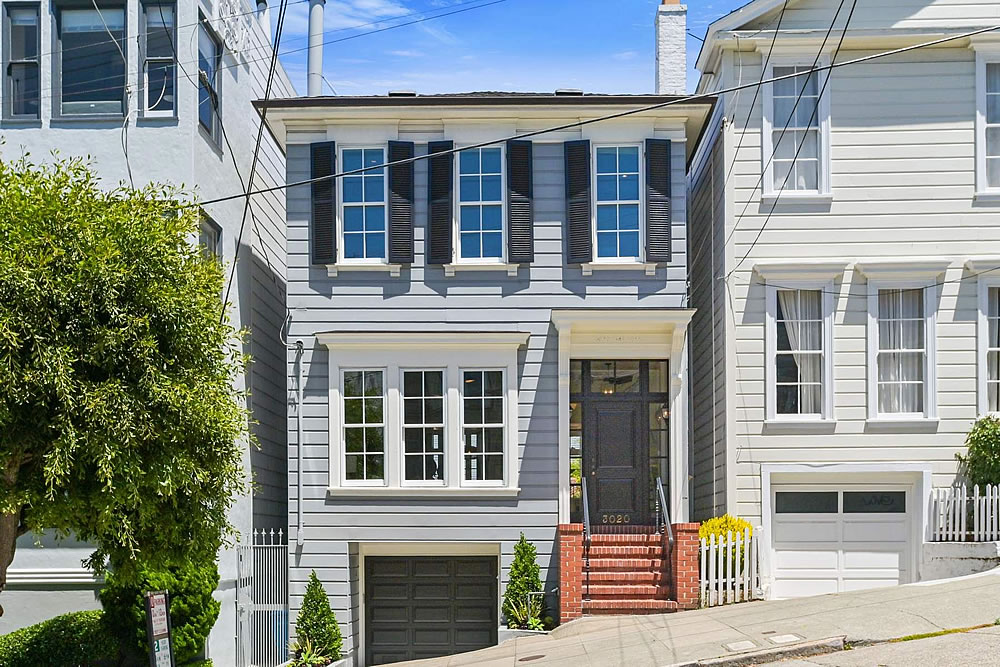Purchased for $2.6 million in August of 2014 and then completely remodeled by Plath & Co, with an emphasis on preserving the home’s historic details and craftsmanship while adding luxury conveniences and finishes, the 2,400-square-foot, single-family home at 3020 Scott Street, “in the heart of Cow Hollow,” sold for $4.255 million in August of 2018.
The 3-bedroom home is outfitted with numerous built-ins, a high-end kitchen with access to the back yard, a lower-level family room and full bath (or fourth bedroom suite), and a one-car garage.
And having returned to the market priced at $3.98 million in June, reduced to $3.68 million in September and then dropped to “$3.38 million” two weeks ago, a sale at which would be considered to be “at asking” according to all industry stats, the Cow Hollow home is now in contract.
And while the Case-Shiller index for Bay Area single-family home values is up 4.0 percent over the same period of time, and the oft quoted “median sale price” is up as well, the re-sale of 3020 Scott Street has just closed escrow with a contract price of $3,188,888, down 25 percent on an apples-to-apples basis but representing “another sale!” of a luxury home.













Look, I don’t pretend to “know the market” in Cow Hollow, but my gut tells me this transaction is a one-off, anomalous…outlier. A 25% decline? The seller must have been really wanting to get out quick and panicked when it didn’t sell by the Fall.
Just goes to show, once again, that you make money in RE when you buy, not when you sell.
Agree, this is yet another extreme example to make a point, but a data point it is, regardless.
Well, when a property is bought, it has x% overhead (seller paid buyer agent commission + recording fees + loan origination fees etc.,) When you buy a car, the worth of the car doesn’t (and shouldn’t) include the tax paid + expenses occurred during purchase of the car .. right? So why would they apply in a RE market?
Probably b/c few individuals buy/sell cars as investments (which isn’t hard to see why: cars don’t generally appreciate). And I would think that those who do in fact DO include those costs…they probably don’t do it for long if they don’t.
Houses are also depreciating assets that require regular maintenance and upkeep.
I agree that it would be possible to recoup expenses in a a rising market. But if the market turns and the property has too many and irrelevant expenses, that can result in a net loss. I think that is the case with this property.
I really think it is a dangerous notion to consider housing as an investment as evidenced in this very post — to a tune of $1M+. That is not peanuts.
I have a hard time believing any one would simply write that off as an absolute loss / minor speed bump and simply move on. I’d be surprised if our elites are really that lackadaisical.
And what about people who live in their cars…huh? I’m really struggling to understand the point you’re trying to make:
– The OP offered up the obligatory “yeah apples>apples, but it’s a BAD apple (so pay no attention)”
– then there was a bizarre – to me at least – retort that “you make money when you buy…not…sell” (I’m guessing this means it’s easier to make money with a shrewd purchase than hoping for either a foolish buyer or a runaway market, but there are plenty of people here who worship at those altars)
– Then you brought in transaction costs; the point being? (Ignoring them makes the loss look smaller, but it doesn’t actually make it smaller)
Your cost basis is determined when you buy but we all know it’s when you sell that money is made or lost. Had this home sold this time last year, maybe they would have a net gain. Or if the sold five years from now, they’d have a gain, but they sold now and took a loss. So it’s when you sell that a gain/loss is booked.
“but my gut tells me this transaction is a one-off, anomalous…outlier. A 25% decline?”
25% down from late 2018. There have been quite a number of apples here at 2015 pricing, so I’m not sure that this is all that much of an outlier. On this post the editor said that case-shiller is up 28.5% since 2015. And pre-covid I think you could use the broad Case-Shiller to estimate SF city prices. So to me this just looks like another in the long list of places going for 2015 pricing.
2015/16 was definitely a hot period in SF real estate, but selling an SF house now for substantially less than you bought it for in 2015 still seems like the outlier. This person took a bath, but there are plenty of anecdotes in the other direction. This house seems to have appreciated nicely in the past four years.
That house is a recently remodeled 5/3 with a yard and parking in what I consider a very safe part of the city. Looks like it did 15% over its 2016 pricing. This 4Br recently remodeled Apple posted here did 10% over 2016 I recall another 4Br that did well.
But I’m not that surprised that recently remodeled 4+ Br’s are doing better then most. Still if you look through the apples to apples category or look at some comps from people trying to sell it looks like there’s a growing bulk of properties going for around 2015 pricing.
If you’re in a 5Br with a yard and parking in a safer part of the city, you probably aren’t feeling as much pressure to leave. So there’s probably less supply. And some people are still moving around and into the city and I can see why those types of properties would be most attractive right now.
15% over 2016 is better than most right now, but compare that to when the market was really on fire and this house gained 21% per year.
Seller listed it near the end of June, changed the price at the beginning of September about 6 weeks later, and then changed it again at the end of October 6 weeks after that, and accepted an offer 2 weeks later. Doesn’t strike me as a panicked sale.
And it’s really not a bad outcome. Sure, they lost well over a million dollars, but they got to live there for two whole years. Two whole years of living among filth and poop, staying indoors due to smoke from fires, and paying among the highest taxes in the world for the privilege. And I think crime in that neighborhood is only up around 60% this year (name link) – which is fantastic, if you don’t actually think about it. I mean it *is* hard for criminals to make the new $0 bail, so that, and the $950 get-out-of-jail-free card, should be putting the brakes on that sort of thing, so I’m expecting crime to drop any day now.
That, in addition to the mortgage, was really a bargain, when the real estate agents and boosters are telling you living among filth and crime while paying high taxes makes this the greatest place in the world, the Paris of the west, etc.
Just don’t think too hard about it, because you just might come to a different conclusion. One that doesn’t involve losing over a million dollars, for starters. And besides, this sale actually *increases* the median price for a home, so the million+ dollars lost is really just academic.
It is what it is. You win some, you lose some.
The breathless “around 60%” increase in reported police incidents for “that neighborhood” as linked is rather misleading as that stat is actually for the entire Northern Police District which includes Western Addition, Pacific Heights, Japantown, Polk Gulch, Russian Hill and the Marina.
Crime up 60% anywhere in the area is a bad sign.
A man was just shot during an armed robbery in Noe, 1 block off 24th at Castro. On Nextdoor/Citizen there have been two other recent reported armed robberies in Noe. And a drive by shooting in Glen Park.
Crime is way up. The 60%+ reporting is an understatement of actual crime. Look on Nextdoor/Citizen. People have given up reporting most property crimes.
Tipster, you clearly [don’t] know the area. Crime in the specific neighborhood is not up 60%. You are referring to the police district, which covers a large area and includes some historically high crime areas. Also, there is no “poop or filth” in the immediate area. Yes, in parts of the city, but not there. And the wildfire smoke ended quite awhile ago. I get you are trolling, but at least know your facts so you don’t look ridiculous.
I’d hardly call Scott Street in Cow Hollow as “Living among the filth and poop,” but I agree that this seemed like a panicked sale to pull the rip cord out of SF. They may have lost a million but they may have seen the writing on the wall and realized that waiting another year may have resulted in a larger loss.
agree mostly, but lombard is quite a mess, particularly west of Scott
Like Brahma did, many people focus on the gain/loss when a property sells. But you’ve got to realize that bidders and buyers don’t really care what the seller paid for the property when they initially bought it. The market today is what it is regardless if you bought in 2000 or 2018.
Sure if you bought in 2000, then getting 2015 pricing just means a little less gravy on your plate. And if you bought in 2018, getting 2015 pricing means a very substantial loss. And I think this is manifesting itself as a lot of pent up supply. You don’t see that many 25% losses, because that’s a hard pill for sellers to swallow especially when you tack on selling costs. People who bought recently and are trying to move out of SF are in a real squeeze because the market just isn’t where they expect here in SF and conversely in many clean/green desirable areas supply is very low and competition is pushing up prices.
I guess we will see what happens when the vaccine rolls out, but for now the problem for 2018-era buyers trying to get out is that the 2015 and earlier buyers are front running them out the door and setting market prices.
It’s not a question of % decline as much as overpaying in 2018. This was never worth $1,773 /SF.
Agreed.
It’s “worth” what someone paid for it. And houses are unique, so you can’t simply compare it to another.
But anyone who’s ever been in a bidding war, or looks at an eBay page, can see the effect of removing (even) a single buyer….worth can suddenly change a whole lot, independent of the item itself.
Not sure poor decision making skills contribute to worth.
Price Volatility is relative to liquidity in time and space. For instance hot water is likely to be expensive in winter than mid-summer. Gold bought at mine is cheaper than gold bought at a jeweler in SF – quantity being the same. It is cheaper to buy water in the airport than on the airplane. Just some basic examples.
I am 100% certain RE pricing in SF rides on the perception of profit potential. It is literally a hope and a belief that prices will go up tomorrow because that is what they did yesterday. It just so happens there are enough number of people who believe in this miracle.
While “you can’t simply compare [one house] to another,” each closed sale does establish a “comp” which is then used to value other properties and transactions, and so on and so forth, as was the case here in 2018 (and yesterday).
Of course; my point is that if someone wants “THAT little house” to the extent that they’ll pay 20, 50…heck 388.5% more per sq.ft. than the average in the neighborhood, than that’s what it was “worth” to them. It’s wrong to say they overpaid.
This property sits a stone’s throw from Lombard so basically resides on a major freeway shoulder. Anyone residing here will be a “sound prisoner” forced to keep windows shut 24/7 and even double-panes won’t save this location. Owner will Rest In Pease when it rains and they hear those tires tearing
At a distance of a little over 400 feet from Lombard, that would be a tough throw for an All-Star MLB outfielder (which any self-respecting Astros fan should know).
Not a rope or a seed, no. Not a flat toss. But if a major leaguer tried to sail one at 45 degrees for max distance, easily.
Considering the world record distance is around 445 feet, that’s not an easy throw (and we’d say impossible with a stone).
Hey man. Can I be you for a second?
Keep in mind that a wider more elliptical 4.5 ounce Franciscan complex projectile hurled from a north facing downslope Scott st position if aided by September or October southerly winds can sail much further than a spherical 5.25 ounce baseball, easily reaching Lombard st. Keep in mind we don’t advise throwing such a projectile in the direction of moving traffic.
I read this site religiously and this string is one of the best.
Guard: What? A swallow carrying a coconut?
King Arthur: It could grip it by the husk!
Guard: It’s not a question of where he grips it! It’s a simple question of weight ratios! A five ounce bird could not carry a one pound coconut.
King Arthur: Well, it doesn’t matter. Will you go and tell your master that Arthur from the Court of Camelot is here?
Guard: Listen. In order to maintain air-speed velocity, a swallow needs to beat its wings forty-three times every second, right?
King Arthur: Please!
Guard: Am I right?
King Arthur: I’m not interested!
[A second guard approaches the parapet]
Guard 2: It could be carried by an African swallow!
Guard 1: Oh yeah. An African swallow, maybe — but not a European swallow, that’s my point.
Oracle is now moving its headquarters to Austin and allowing employees to choose their location. The trend, of companies leaving the bay area and allowing employees to choose, is accelerating. The high tax, high cost, low quality-of-life, bay area is finished.
We’ll know you’re correct when and if people from flyover country start moving en masse to low-tax Texas to exploit the local population of highly paid workers and realize their dreams of being a celebrity real estate agent like Fredrik Eklund. Until that happens, I’d be skeptical of the trend really accelerating.
The trend is accelerating. Knowledge/Information based workers need no longer be anchored to any particular location. One reason Austin stands out is because of all the work the city and the surrounding regions did to bring Fiber to Home (FTH). Pretty much any city that has put in the work to enable FTH is viable for remote commuting. SF and the Bay Area on the other hand are laggards in this respect.
The trend will further accelerate once Starlink (Elon’s Satellite Internet Company) is fully operationalized. It’s currently in testing.
My bet is that this is an exec relo.
Bought with company subsidy, sold by a third party for a fee
It is of the market but it is not the market